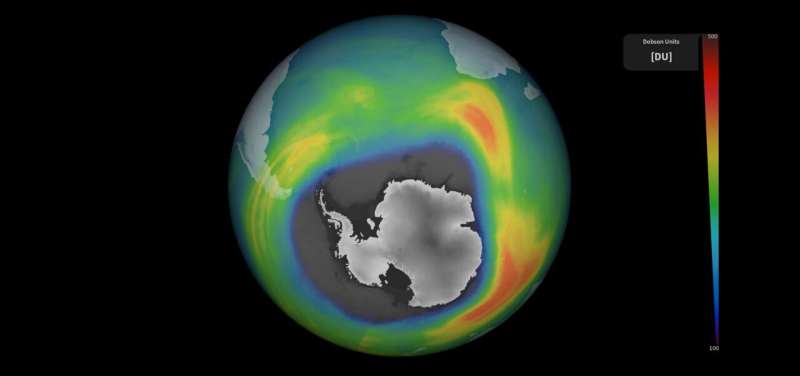This article has been reviewed according to Science X's editorial process and policies. Editors have highlighted the following attributes while ensuring the content's credibility:
fact-checked
trusted source
proofread
Ozone hole grows large again

Measurements from the Copernicus Sentinel-5P satellite show that this year's ozone hole over Antarctica is one of the biggest on record. The hole, which is what scientists call an "ozone depleting area," reached a size of 26 million sq km on 16 September 2023. This is roughly three times the size of Brazil.
The size of the ozone hole fluctuates on a regular basis. From August to October, the ozone hole increases in size—reaching a maximum between mid-September and mid-October. When temperatures high up in the stratosphere start to rise in the southern hemisphere, the ozone depletion slows, the polar vortex weakens and finally breaks down, and by the end of December ozone levels return to normal.
Launched in October 2017, Copernicus Sentinel-5P—short for Sentinel-5 Precursor—is the first Copernicus satellite dedicated to monitoring our atmosphere. It is part of the fleet of Copernicus Sentinel missions that ESA develops for the European Union's environmental monitoring program.
The satellite carries an advanced multispectral imaging spectrometer called Tropomi. It detects the unique fingerprints of atmospheric gases in different parts of the electromagnetic spectrum to image a wide range of pollutants more accurately and at a higher spatial resolution than ever before.
The Tropomi total ozone measurements are processed within the Sentinel-5P ground segment at the German Aerospace Center (DLR) using algorithms that has been developed by DLR and the Royal Belgium Institute for Space Aeronomy (BIRA-IASB).
Diego Loyola, DLR senior scientist, commented, "The Sentinel-5P total ozone products have an accuracy at the percentage level compared with ground-based data and this allows us to closely monitor the ozone layer and its evolution. The Tropomi measurements are extending the global ozone data record of European satellite sensors covering almost three decades."
The Sentinel-5P total ozone column product is provided within three hours after measurement time to the Copernicus Atmosphere Monitoring Service (CAMS). CAMS, which is implemented by the European Center for Medium-Range Weather Forecasts (ECMWF) on behalf of the European Union, includes these near-realtime Sentinel-5P ozone data in their data analysis and forecast system.
CAMS senior scientist Antje Inness, said, "Our operational ozone monitoring and forecasting service shows that the 2023 ozone hole got off to an early start and has grown rapidly since mid-August. It reached a size of over 26 million sq km on 16 September making it one of the biggest ozone holes on record. Tropomi ozone data are an important dataset for our ozone analysis."
Why is the ozone hole so big?
The variability of the size of the ozone hole is largely determined by the strength of a strong wind band that flows around the Antarctic area. This strong wind band is a direct consequence of Earth's rotation and the strong temperature differences between polar and moderate latitudes.
If the band of wind is strong, it acts like a barrier: air masses between polar and temperate latitudes can no longer be exchanged. The air masses then remain isolated over the polar latitudes and cool down during the winter.
Although it may be too early to discuss the reasons behind the current ozone concentrations, some researchers speculate that this year's unusual ozone patterns could be associated with the eruption of the Hunga Tonga-Hunga Ha'apai in January 2022.
Antje explains, "The eruption of the Hunga Tonga volcano in January 2022 injected a lot of water vapor into the stratosphere which only reached the south polar regions after the end of the 2022 ozone hole.
"The water vapor could have led to the heightened formation of polar stratospheric clouds, where chlorofluorocarbons (CFCs) can react and accelerate ozone depletion. The presence of water vapor may also contribute to the cooling of the Antarctic stratosphere, further enhancing the formation of these polar stratospheric clods and resulting in a more robust polar vortex."
However, it's important to note that the exact impact of the Hunga Tonga eruption on the Southern Hemisphere ozone hole is still a subject of ongoing research. This is due to the absence of previous instances where such substantial amounts of water vapor were injected into the stratosphere in modern observations.
ESA's mission manager for Copernicus Sentinel-5P, Claus Zehner, adds, "The Sentinel-5P total ozone columns provide an accurate means to monitor ozone hole occurrences from space. Ozone hole phenomena cannot be used in straightforward manner for monitoring global ozone changes as they are determined by the strength of regional wind fields that flow around polar areas."
The lingering impact of ozone depleting substances
In the 1970s and 1980s, the widespread use of damaging chlorofluorocarbons in products such as refrigerators and aerosol tins damaged ozone high up in our atmosphere—which led to a hole in the ozone layer above Antarctica.
In response to this, the Montreal Protocol was created in 1987 to protect the ozone layer by phasing out the production and consumption of these harmful substances, which is leading to a recovery of the ozone layer.
Claus concludes, "Based on the Montreal Protocol and the decrease of anthropogenic ozone-depleting substances, scientists currently predict that the global ozone layer will reach its normal state again by around 2050."
ESA has been involved in monitoring ozone for many years. Launched in October 2017, Copernicus Sentinel-5P satellite is the first Copernicus satellite dedicated to monitoring our atmosphere. With its state-of-the-art instrument, Tropomi, it is able to detect atmospheric gases to image air pollutants more accurately and at a higher spatial resolution than ever before from space.
Provided by European Space Agency





















